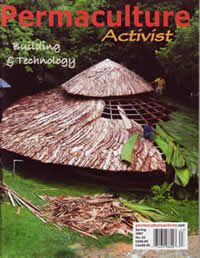About This Kickstarter Project
Permaculture Activist has served the North American permaculture community and readers around the world for nearly 30 years. It receives no public funding and has consistently garnered high regard for dedication to grassroots learning and design intelligence. We report stories from readers, activists, designers, teachers, and community organizers across the continent and beyond to reveal the newest discoveries in ecological systems. We attempt to work at the permaculture edge.
Permaculture Activist has served the North American permaculture community and readers around the world for nearly 30 years. It receives no public funding and has consistently garnered high regard for dedication to grassroots learning and design intelligence. We report stories from readers, activists, designers, teachers, and community organizers across the continent and beyond to reveal the newest discoveries in ecological systems. We attempt to work at the permaculture edge.
 For most of its duration, the magazine has been published by Peter Bane, a prominent educator and author of The Permaculture Handbook: Garden Farming for Town and Country.Peter is now turning over the publisher’s duties and business responsibilities to editor John Wages, who first joined the staff in 2004. We are taking the occasion between our 30th anniversary (July 2015) and soon-to-be our 100th issue (May 2016) to give the publication a full refresh and a new name (Permaculture Design), and to expand its outreach and capabilities. We need your help.
For most of its duration, the magazine has been published by Peter Bane, a prominent educator and author of The Permaculture Handbook: Garden Farming for Town and Country.Peter is now turning over the publisher’s duties and business responsibilities to editor John Wages, who first joined the staff in 2004. We are taking the occasion between our 30th anniversary (July 2015) and soon-to-be our 100th issue (May 2016) to give the publication a full refresh and a new name (Permaculture Design), and to expand its outreach and capabilities. We need your help.
Our plans call for implementing a new website and a streamlined user interface, with a new look, and expanded offerings. We have recently completed indexing of the first 90 issues of the magazine, which with annual updates, will provide us and our readers ready access to thousands of pages and hundreds of stories from some of the most creative and insightful ecological designers in the world. Treasures lie in our relatively obscure past, and these can now be brought into wider circulation with your help. We hope to digitize older stories and make these available.
We are in touch with a wide and active network of permaculture designers and educators whose knowledge base is incalculably valuable and inspiring. Many of their stories have yet to be written or documented. With your help, we will be able to reach further into the cutting edge of grassroots research and design, and to bring these stories to public attention. We want to activate this network of permaculture researchers as citizen-journalists, and to help them in turn inform and empower their communities.
Permaculture Activist has always operated close to the ground, to its readers and subscribers. Though we have commercial circulation through magazine wholesalers, we have never depended on complex business schemes to do our work. The business has been run conservatively and has no debts. But its access to capital is limited. With your help, we can readily add features, strengthen operations, and smooth an historic management transition.
Publisher Peter Bane, soon to be emeritus, will continue to contribute reviews and features to the magazine’s pages. We expect to begin e-publishing of an online version in the next year. We are actively seeking new columnists and guest editors, and as we have for nearly a decade, we continue to receive more high quality stories than we can fit into the pages of our quarterly journal. An expanded web presence will allow us to air some of these stories in a more timely manner in conjunction with the print magazine.
We also hope to open a wider channel for reader input: letters, short reports, reference links, and much more. All this depends on our ability to take time (thus money) to step beyond our current roles. You can help. Please give as much as you can to this fundraising campaign, and spread the word to everyone you know. We believe the reservoir of goodwill for permaculture work and for our publishing efforts is deep. This is the time to demonstrate our commitment to permaculture ethics of fair share and people care.
With thanks for all your efforts.
Risks and challenges
We have proposed a very achievable project to make the Permaculture Activist (Permaculture Design) more useful and more easily accessible to the community by giving the website a new architecture and user interface, implementing an online edition of the magazine, and digitizing past content for ease of retrieval.
We do not expect any unique problems with enhancing the Activist's online and digital presence. There are, of course, challenges. A good portion of the back content is only readily accessible in printed format and will need to be scanned, checked, and the files organized. Though mechanical and ordinary, this work may take longer than we have now anticipated. It does not, however, require skills that we do not already have as experienced editors and publishers.
To implement new website architecture and create a new user interface, we have secured an experienced web designer with permaculture training and an impressive portfolio. We have assembled a team of Web-savvy permaculturists to provide feedback on website usability and the best approach to a digital edition. This expert panel includes farmers, writers, activists, and engineers, from diverse backgrounds. After the new site architecture is in place, we will need some time to port over existing content and add new material. The present webmaster, Keith Johnson, has agreed to assist in this work. We have other people lined up to support this process, but don’t have a clear idea yet of how much time it will take. We are hopeful this can be done within two months.
We have prioritized our tasks as follows: 1) design and implement the new website, 2) reorganize current content into a format appropriate for an e-version with the intent to publish this as a supplement to our print edition, and 3) digitize past content with the intent of making it available to subscribers. The back issues of the magazine from 1985-2013 have already been indexed, which provides a means to locate past articles on various subjects. This gives us great flexibility in creating compendia and collections of useful material. The indexes have been created incrementally and in two categories: general subjects, and species of interest. It may require some days of effort to integrate these documents and render them fully accessible from one interface. However, we don’t expect this will pose any barriers, and once this has been done, we will have a master key to the treasures held within the body of our more than 95 editions.
We have additional future plans for the Activist. Some of these ideas were discussed at the North American Permaculture Convergence in Minnesota last year, where a large cross-section of the community gave valuable input. Achieving the first three goals will bring us closer to the realization of our full vision for the publication. As present publishers and editors of the magazine, we derive partial livelihoods from it and are committed to its continuation for both personal and professional reasons. We believe that this campaign can greatly help secure a stable future for this important community asset, and moreover, that it will ease the effort required from us to keep the publication vital and active.
